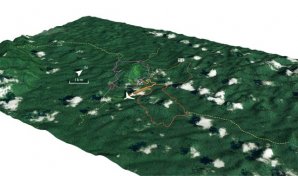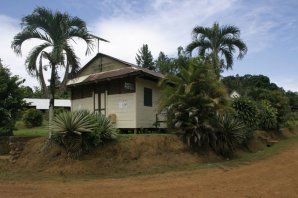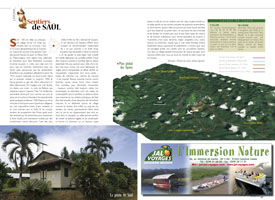Saül is already nearly 100 years old. The village sprang up due to gold mining, but intends to outlive it. It lies at the geographical centre of French Guiana, where a knot of springs give rise to three of the great rivers of country – the Mana, the Inini, and the Approuague. With its many valleys and dense forests it is not an easily accessible region. As is often the case it took a gold rush for men to strike out into these areas which had previously been the territory of the Emerillon Amerindians. Gold miners started arriving in number from 1910 onwards, following the example of Saint-Lucien Sahul who was the first to arrive there. Until 1950 the town grew in tandem with the discovery of new seams, and it became necessary to establish transport links. A railway was planned and a road built, the Bélizon trail which wends its way as far as Cayenne. But the amount of easily mineable gold started to tail off, as did its price, and the trail served primarily for the flight of its inhabitants, before being abandoned shortly afterwards in the 1960s. Since then the only way to get to Saül is by plane. As for the villagers, there are less than 100 of them left today, and they are focused on the forest. The old Mine Prospection trails, which were reused by botanists to draw up an inventory of the local flora, are now the haunt of hikers who come to discover one of the most beautiful forests in the National Park of French Guiana. The local inhabitants offer them advice and recommend ‘not actually walking’ in the forest, as that makes too much noise, and to ‘mime walking instead. And to be light on your feet, and keep your eyes peeled and ears open, with your binoculars at the ready. You always need to be ready to freeze mid-step with one leg in the air. Do not go forwards so as to get from A to B, but so as to see better and explore blind spots, understand a detail, check a movement, approach a noise, and use your sense of smell. There is no point trying to walk at your preferred pace, as the pace is determined for you. Root, dead branch, root, branch, root, root, dead trunk, fallen branch. Then it is uphill and downhill the whole time – though never very long, the slopes are always steep. Those looking to notch up the miles will soon have to admit defeat, whereas those who wish to gaze will be content. Distance does not count and so the main footpath around Saül form loops of a dozen or so kilometres. The paths form a clover leaf shape around the village. Alongside these paths, spectacular trees shoot up to the sky and only spread out their branches once they have reached the canopy. The terrain means that it is sometimes possible to stand above this roof of plants and contemplate the dispersing mist or a king vulture soaring overhead. Beneath, the rivers are like rubies, flowing over sand and the grooved rocks used by the Amerindian to sharpen tools. The land is home to shy wildlife that is best observed at dawn when the undergrowth is damp and the leaves do not make any noise underfoot. With luck and good directions you might get to see otters, a common sight here, as well as tamarins, spider monkeys, macaws, coatis, curassows, and motmots, whilst at night your headlamp might well surprise armadillos, opossums, and amphibians. Unless that is you decide to spend your evenings with the friendly inhabitants of Saül. For in this village full of nature lovers, people are happy to spend time with you, in the middle of nowhere right in the heart of French Guiana.




 English
English Français
Français  Português
Português 








 Télécharger l'article en PDF est réservé aux abonnés Web !
Télécharger l'article en PDF est réservé aux abonnés Web ! 
 Pas de réaction
Pas de réaction Comment!
Comment!


 Voyages avec Tooy. Histoire, mémoire, imaginaire des Amériques noires : Editions Vents d’ailleurs, 2010
Voyages avec Tooy. Histoire, mémoire, imaginaire des Amériques noires : Editions Vents d’ailleurs, 2010
 Guyane. Produits du terroir et recettes traditionnelles. L’inventaire du patrimoine culinaire de la France : Editions Albin Michel, 1999
Guyane. Produits du terroir et recettes traditionnelles. L’inventaire du patrimoine culinaire de la France : Editions Albin Michel, 1999
 Alunawalé, un voyage à travers les milieux naturels de Guyane : Office National des Forêts, 2009
Alunawalé, un voyage à travers les milieux naturels de Guyane : Office National des Forêts, 2009
 Augusta Curiel, Fotografe in Suiriname 1904 – 1937 : Libri Misei Surinamensis, 2007
Augusta Curiel, Fotografe in Suiriname 1904 – 1937 : Libri Misei Surinamensis, 2007



